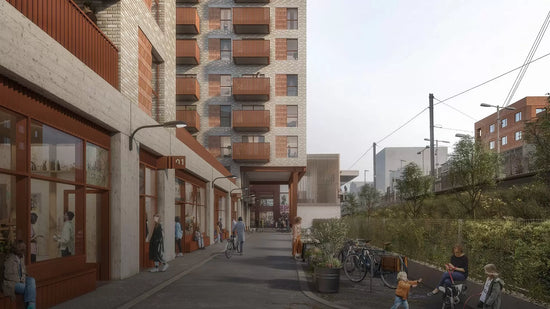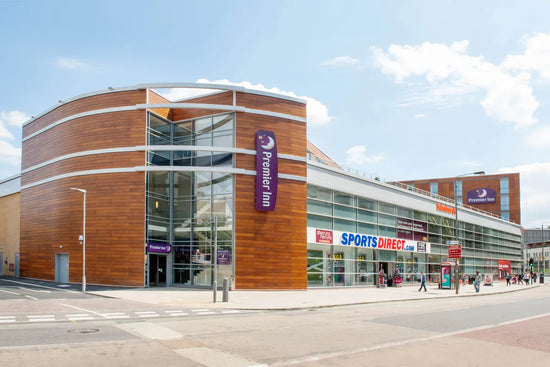The Grenfell Tower fire in June 2017 highlighted the importance of building materials' fire performance particularly in relation to high-rise buildings. After the tragedy, government and regulatory bodies conducted a review of building regulations, guidance, and testing requirements to ensure that buildings are safe in case of a fire. Since Grenfell, there has been increasing recognition of the need to undertake fire testing of the wall construction itself to provide a ‘through-wall’ performance, providing designers and contractors with added assurance of a solution’s performance capabilities.

When you consider any public building or buildings with sleeping accommodation in residential, hotel, student accommodation, social housing, healthcare and education, the need for these to have high levels of fire protection and safety is clear.
The appeal of light frame steel framing systems (SFS), for developers and designers alike, is that the systems are lightweight, versatile, and cost efficient. SFS are primarily used for wall constructions, such as infill walling, continuous walling, high bay walling and load bearing structures. While there can be little denying that the qualities possessed by SFS are extremely desirable, the issue lies with the fact that these are almost worthless without certified fire performance. When it comes to SFS, the level of fire resistance is achieved by a combination of materials that are then combined with the SFS to make the wall to provide the required technical performance standards in the areas of acoustics, thermal efficiency and, most importantly, fire protection.
If you were to look at an external wall, this would typically be made up of internal dry lining, SFS, insulation and external sheathing board. Through-wall fire testing with sheathing boards is particularly important in the context of fire safety and the evaluation of building materials and systems in high-rise buildings. Sheathing boards, such as gypsum boards or cement boards, are commonly used as a protective layer in wall assemblies to enhance fire resistance in conjunction with the SFS.
What is through-wall fire testing?
Through-wall fire testing helps determine the effectiveness of sheathing boards in enhancing the fire resistance of the overall wall system. It assesses factors such as flame spread, heat transfer, and structural integrity when sheathing boards are exposed to realistic fire conditions. This information is crucial for ensuring that the chosen sheathing boards adequately enhance the fire performance of the walls.
A through-wall is the part of the wall responsible for the majority of thermal, acoustic, and fire properties. It is a series of components that, when tested together, can provide evidence of compliance. Considered to be from the inner plasterboard lining to the sheathing board, fixed to a light gauge steel framing, sometimes this will include the insulation on the face of the sheathing board.
The importance of through-wall fire testing is simple. With such an array of external facade materials available, it becomes almost impossible to test every combination based on theory alone. Compiling the data from each individual element simply isn’t enough to provide a definitive assessment as to the true fire resistance.
With through-wall fire testing, manufacturers can test, in practice, a combination of materials so that they can be assessed. The results mean that design teams are then able to make informed choices when it then comes to the external facade. They have the tested performance in front of them that proves that the required standards are met.
How is through-wall fire testing carried out?
When it comes to assessing passive fire protection, the Building Regulations set out requirements for time performance, particularly regarding integrity (passage of smoke and flame), insulation (temperature on the opposite side of the wall) and load bearing capacity where the wall is being used in a structural capacity.
To obtain the required performance to show the levels of fire resistance, manufacturers need to carry out fire testing at UKAS accredited laboratories. They do this by constructing complete wall build-ups that consist of light gauge steel frames and then feature a range of fire-resistant boards and insulation.
Each build-up is tested using a large scale 3m x 3m, high heat test (reaching up to 600 degrees Centigrade in 5 minutes), which measures the performance of the whole wall by simulating fire trying to break out through a solid wall. The test is designed to determine the rate of fire spread and the ability of the building materials or assemblies to contain the fire.

Non-load bearing wall fire tests are carried out to the BS EN 1364-1 standard. When these standards are awarded, it means that typically the external walls achieve the 60-minute, 90-minute, and 120-minute ratings that are required by the Building Regulations. In most cases, fire performance is an inside to out requirement, aiming to prevent the spread of fire from its source to adjacent compartments. However, where buildings are in close proximity to each other fire resistance will also be required from outside to in.
How Klasse Group reaches the standards?
As a family-owned, UK-based company, we firmly believe in building a safer future and deliver fire tested, non-combustible product solutions.
When it comes to our sheathing boards, our boards are through-wall fire tested carried out by a UKAS accredited laboratory. Understanding the need for inside-to-out and outside-to-in fire resistance which can be equally important, we are pleased to say that in both instances, our product achieves the BS EN 1364-1 EI 90-minute standard (insulation and integrity).
Final thoughts
Post the Grenfell fire, there have been significant improvements in through-wall fire testing standards that now require that building materials and assemblies be tested to evaluate their fire performance, including their ability to contain the spread of fire. Through thorough testing, the safety of building occupants can be improved, property damage can be minimised, and fire protection measures can be enhanced.

The ability, and the need, to test a combination of materials means that the future of construction is one that now focuses fire safety. As things continue to develop fire resistance will remain the top priority, but we need to be mindful of not compromising other essential elements of design and functionality of any building.
Early engagement with the supply chain will ensure compliance with building regulations and the appropriate fire resistance required, validation of manufacturers' claims and optimisation of the system design.





